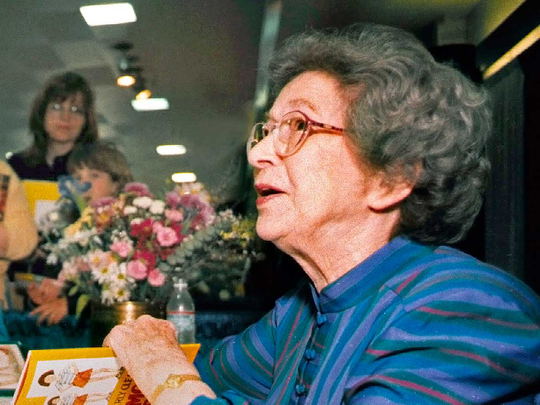
Ramona drummed harder to show everyone how bad she was. She would not take off her shoes. She was a terrible, wicked girl! Being such a bad, terrible, horrid, wicked girl made her feel good! She brought both heels against the wall at the same time. Thump! Thump! Thump! She was not the least bit sorry for what she was doing. She would never be sorry. Never! Never! Never!
One of the world’s great inventions, only a little behind the light bulb, was Ramona Quimby, the strong-willed, lovable and exasperating star of “Ramona the Pest” and other books. For decades the Ramona books have been a gateway drug luring young readers into the spellbinding world of books.
Ramona’s inventor, Beverly Cleary, has sold 85 million copies of her books about Ramona, Henry Huggins, Ralph S. Mouse and other beloved figures. Cleary will turn 100 on Tuesday, so I asked her about her characters, her life and her wisdom.
Now living in a retirement home in Carmel, California, she immediately disclaimed any grand thoughts about reaching a century.
“I didn’t plan on it,” she explained dryly.
Cleary’s only long-range plan is that when the time comes, she’ll return to her hometown, Yamhill, Oregon, to be buried beside her late husband in the local cemetery. As it happens, I’m also from Yamhill, population about 1,000, and Cleary is our hometown hero.
“Miss Binney, I want to know — how did Mike Mulligan go to the bathroom when he was digging the basement of the town hall?” Miss Binney’s smile seemed to last longer than smiles usually last. Ramona glanced uneasily around and saw that others were waiting with interest for the answer.
As a girl, Cleary was a late reader because she didn’t find most children’s books very interesting. In her first-grade class, she was assigned to the lowest reading group, the Backbirds, and her teacher, Miss Falb, beat her on the palms for daydreaming.
So Cleary tried to drop out of school in the first grade. But her parents forced her to keep going, and Cleary eventually excelled in school and in college and found a job as a librarian in Yakima, Washington. A boy there complained that there weren’t any books about kids like him.
In response, Cleary sat down and wrote about Henry Huggins and his dog, Spareribs. She thought her characters needed siblings, so she decided to torment Henry’s friend Beezus with a pesky little sister “and at that moment someone called out ‘Ramona,’ so I named her Ramona”.
An editor suggested a few changes — such as turning “Spareribs” into “Ribsy” — and the book was published to immediate acclaim. Later volumes followed, including a series focused on Ramona, one of the great figures in children’s literature.
Cleary says Ramona is her favourite character but isn’t directly modelled on her. “I was a well-behaved girl,” she said, “but I often thought like Ramona”.
Cleary’s works depict ordinary events drawn from her own childhood. Her cousin once caught a salmon with his bare hands, so she had Henry Huggins spotting and tackling a 29-pound salmon in an ocean stream. That left a deep impression on me as a boy, and ever since I’ve looked carefully in ocean streams for monster salmon.
In telling these stories, Cleary always refrains from inflicting larger lessons.
“As a child, I very much objected to books that tried to teach me something,” she told me. “I just wanted to read for pleasure, and I did. But if a book tried to teach me, I returned it to the library.”
Miss Binney taught the class the words of a puzzling song about “the dawnzer lee light,” which Ramona did not understand because she did not know what a dawnzer was. “Oh, say, can you see by the dawnzer lee light,” sang Miss Binney.
Cleary says that when she goes back to Yamhill, everything seems the same as ever — except that now the kids aren’t playing in the streets but are inside watching television.
There’s something to that. On any given day, US children ages eight to 12 consume almost six hours of entertainment, such as television, video games and social media, according to polling by Common Sense Media. Aside from schoolwork, 57 per cent of those kids typically don’t read at all.
We measure child poverty by household income, but a better metric might be how often a child hears stories read aloud. To honour Cleary’s birthday, school organisations are calling on kids and parents to “drop everything and read”.
So it’s time to take a break from sordid politics to celebrate authors like Cleary who inspire us to read. Let’s make what Ramona would call “a great big noisy fuss” about her creator’s 100th birthday — for as they invent new worlds, great writers enrich our own.
— New York Times News Service
Nicholas Kristof is an American journalist, author, columnist, and a winner of two Pulitzer Prizes.








